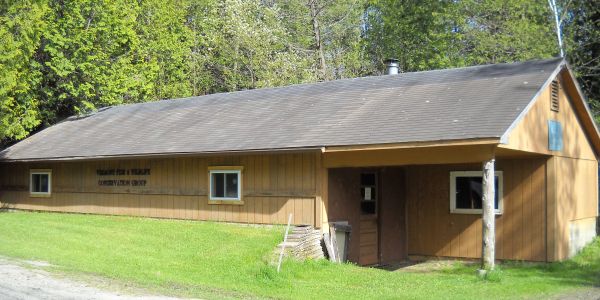Morgan Cooperative Fish Hatchery
History
Up to 1932 the so-called eyeing station at Morgan was operated for only a short time each year in carrying salmon and trout eggs to the eyed stage before transporting them to the hatcheries. The Morgan plant was of temporary construction, but by the mid-thirties remodeling seemed necessary if use of the station was to continue.
The roof was rebuilt, the walls repaired and the trough supports replaced. These repairs were made as economically as possible. By 1947 the land had been leased at Morgan to provide a permanent eyeing and rearing station. A building was erected and in 1950 this station was operated as a brook trout rearing station with very encouraging results.
Brook trout fry were taken from Salisbury to Morgan and as growth made thinning necessary they were taken to Canaan, Bald Hill and some to York Pond as replacements for losses at that station.
Director George W. Davis hailed the new policy at Morgan as the answer to fall stocking of several ponds in the northeast sector of the state. He pointed out in his report at that time that it became possible to stock as fingerlings more than 200,000 brook trout that would have been planted as fry.
The hatchery was abandoned and torn down sometime in the 1970’s. The Vermont Fish and Wildlife Conservation Group rebuilt the building on the old site with the help of volunteers and donated materials in 1991. A $10,000 grant from Fish America paid for incubators and tanks, and the VT Fish and Wildlife Department supplied the eggs.
The first fish were put out in April of 1993 (160,000) with the assistance of a number of members and youngsters through the local Boy and Girl Scout troops. Our volunteer hatchery technicians spend up to two hours daily cleaning the tanks, feeding the fish, and picking dead fish and eggs. They perform this duty from the end of November until the fish are all stocked, usually mid-April. Since the first stocking in 1993, tens of thousands of brook trout fry have been raised and stocked from the hatchery each year.
Here is the data
Year Eggs Received / Fish Stocked
1995 256,000 / No Data Available
1996 No Data / 257,000
1997 256,000 / 250,000
1998 260,000 / 116,000
1999 No Data / No Data Available
2000 205,000 / 91,675
2001 100,000 / 108,380
2002 92,300 / 71,733
2003 102,000 / 80,334
2004 115,000 / 73,780
2005 168,900 / 140,370
2006 176,000 / 171,000
2007 143,500 / 134,292
2008 139,000 / 114,000
2009 160,000 / 132,720
2010 159,000 / 132,720
2011 153,000 / 124,800
2012 47,712 / 37,800
2013 60,000 / 74,600
2014 110,000 / 90,400
2015 97,000 / 70,650
2016 123,000 / 71,000
2017 108, 079 / 85,800
2018 99,690 /79,000
_____________________
1,881,154 – Fish stocked to this date!
Probably the signature program for Vermont Fish and Wildlife Conservation Group is the successful operation of our fish rearing facility in Morgan. For over two decades, and nearly 2 million fish , our group has been raising fish from eggs to fry under the watchful eyes of the Fish and Wildlife staff from the Bald Hill Hatchery. Each winter countless hours have been volunteered by dedicated members and directors of this group to rear these fish to the point where they may be released into the wild. We are raising and stocking these fish to provide fishing opportunities in newly formed beaver ponds and in places where brook trout are able to survive but probably not able to reproduce in local areas of the Northeast Kingdom.
This facility is located on Eliot Acres Rd in Morgan, VT on the site of the old Morgan State Fish Hatchery. With permission from the state, the VTFWCG resurrected the building, refurbished the equipment and began raising fish there in the early 1990’s. A decade later, with some additional renovations, the building was adapted to become our base of operations, where we hold our monthly meetings. The Meetings are open to the public and are held the first Thursday of every month starting at 7PM. We invite you to join us and help in our conservation efforts!
Anyone interested in touring our facility or interested in helping out stocking fry stocking (late March – early April) can make arrangements with either Conrad Fortin (802-766-51950 or Peter Engels (802-723-5950).
